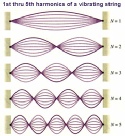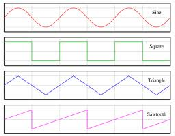









Page 17
Click to access Esoterics of Sound
LEARNING BLOCKS Sound and Vibration l Voice l Chakras l Energy l Singing l Sound Healing Tools l Color l Senses
Music Therapy l Resources l Sound Healing Sessions l Applications

Sound is an energy form caused by the back and forth movement of molecules and atoms, termed vibration. In our multiverse all things vibrate. Thus, all things produce sound, some heard, and, many, unheard.
An energy force acting on an elastic material is the source of the sound. The material is set in motion and moves through a medium in proportion to the amount of the initial energy force.
moves through a medium in proportion to the amount of the initial energy force.
Sound produces waves. A wave is a periodic movement of the medium, usually air, moving in repeating patterns or cycles. The wave is actually a periodic compression of molecules called sound pressure waves. The waves appear with equal crests and troughs over a period of time.
 Along the continuum when the wave returns to the starting point it is termed a complete cycle. The wave cycle is measured over seconds, thus cycles per second, or cps. The rate of vibration is the number of complete cycles of the wave per second: 440 cps means 440 back and forth oscillations per second. The rate of vibration is another name for the acoustical term frequency as well as the musical term pitch.
Along the continuum when the wave returns to the starting point it is termed a complete cycle. The wave cycle is measured over seconds, thus cycles per second, or cps. The rate of vibration is the number of complete cycles of the wave per second: 440 cps means 440 back and forth oscillations per second. The rate of vibration is another name for the acoustical term frequency as well as the musical term pitch.
Picture a string that is anchored at both ends. When it is plucked, or put into motion, it starts to vibrate in cycles per second, providing a pitch, or frequency, that will be heard by the human ear. The more force applied to the string when it was plucked, the greater the crests and troughs of the wave. This is called the amplitude of the string or the loudness of the sound.
Sound moves in spherical waves out from its source in all directions.  Thus, no matter where we are in relation to a sound source, we hear it. Sound requires a medium through which to move. It travels through various states of matter, air, water, wood, metal, human body, etc., at varying speeds. It travels through air at 760 miles per hour, steel at 11,200 mph, and glass at 12,500 mph. However, though the speed is faster, the material density causes the sound to fade away faster.
Thus, no matter where we are in relation to a sound source, we hear it. Sound requires a medium through which to move. It travels through various states of matter, air, water, wood, metal, human body, etc., at varying speeds. It travels through air at 760 miles per hour, steel at 11,200 mph, and glass at 12,500 mph. However, though the speed is faster, the material density causes the sound to fade away faster.
Sound waves move through water at 3350 mph. The human body is two thirds water. Herein lies one of the reasons sound is such a powerful modality when working with the body. More, much more, later...we are providing scientific foundation and background in this section.
 The wavelength of a sound is the distance between the beginning and the end of the cycle. The higher the pitch , or frequency of the sound, the shorter the wavelength. Conversely, the longer the wavelength, the lower the frequency or pitch. Thus, low sounds travel farther, which helps to understand why we hear the rumble of thunder from a farther distance. It also helps to understand why we hear the bass from music in the club down the street or the car next to us. Higher frequencies dissipate quickly.
The wavelength of a sound is the distance between the beginning and the end of the cycle. The higher the pitch , or frequency of the sound, the shorter the wavelength. Conversely, the longer the wavelength, the lower the frequency or pitch. Thus, low sounds travel farther, which helps to understand why we hear the rumble of thunder from a farther distance. It also helps to understand why we hear the bass from music in the club down the street or the car next to us. Higher frequencies dissipate quickly.
Each object has its own frequency of vibration. In a process known as resonance, a sound source produces sound waves that impart energy on objects around it. If the objects have that same frequency of vibration, they will begin to sound. When a note on the piano is sounded with the sustain pedal held, other strings of the same frequency will also vibrate. Resonance is an ally of the sound healer. We will discuss this more in future blocks.
A string vibrates, as determined by Pythagoras, not only as a whole but at calculated segments of halves, thirds, fourths, fifths, sixths, sevenths, and so on up to sixteenths. All parts vibrated in the same manner as the whole string, or fundamental, except at faster rates and higher frequencies. The distance between each of these segments is mathematical and can be expressed in musical terms as intervals, or the distance between two pitches. Each pitch beyond the fundamental is call a partial, an overtone, or a harmonic. It is these harmonics that give sounds their unique character, or timbre. The various amplitudes of each of these harmonics will define a sound to be identified by the human ear: a guitar or a violin or a harmonica or a bassoon...
distance between two pitches. Each pitch beyond the fundamental is call a partial, an overtone, or a harmonic. It is these harmonics that give sounds their unique character, or timbre. The various amplitudes of each of these harmonics will define a sound to be identified by the human ear: a guitar or a violin or a harmonica or a bassoon...
We shall also see that overtones and harmonics are one of the key elements in the use of voice as a tool for sound healing. The harmonic structure of the multiverse comes into discussion when we look in greater depth at harmonics as well. Very exciting.
 A simple fundamental sound wave is a sine wave. Simple waveforms are continuous and repetitive. Simple musical waveforms are the sine, the square, the triangle, and the sawtooth. These wave forms typically form the basis of musical sound synthesis. Let’s listen to some audio samples of each. Also, you can hear the harmonic series in the key of C, as well as pitch and frequency samples.
A simple fundamental sound wave is a sine wave. Simple waveforms are continuous and repetitive. Simple musical waveforms are the sine, the square, the triangle, and the sawtooth. These wave forms typically form the basis of musical sound synthesis. Let’s listen to some audio samples of each. Also, you can hear the harmonic series in the key of C, as well as pitch and frequency samples.
 In addition to simple waves there are complex waves. These do not necessarily repeat nor remain symmetrical. Spoken words, gongs, cymbals, bells and percussive sounds fall into this category. Complex waves can contain many blended pitches, the most extreme being white noise, which contains all frequencies. These waves can be used as washes or as percussive sharp sounds to dispel a particular frequency. Listen to some samples of complex waveforms.
In addition to simple waves there are complex waves. These do not necessarily repeat nor remain symmetrical. Spoken words, gongs, cymbals, bells and percussive sounds fall into this category. Complex waves can contain many blended pitches, the most extreme being white noise, which contains all frequencies. These waves can be used as washes or as percussive sharp sounds to dispel a particular frequency. Listen to some samples of complex waveforms.
For the sound alchemist the physics of sound provides foundation for the use of pitched sounds as tools to effect the vibration of an organ, system, or emotion. Harmonic knowledge opens up the doors to influencing the timbre of an object. Wave length allows one to determine the best frequencies to support an area. The tonal shifts that occur via amplitude changes allows a sensitivity to the strength of a pitch to effect an organ or group of cells. Knowing that sound is spherical and 3 dimensional allows the alchemist to vary his location for easier access to an area. Simple wave forms are exemplified by the quartz bowls that are pitched...powerful sound tools. The Tibetan metal bowls are a harmonically rich sample of complex waves highly usable to effect vibration.
To review the physics of sound please take 10 minutes to view this classic video from 1933 by Encyclopedia Britannica. It’s a walk back in time but still information relevant...
Sound Healing History l Contemporary Sound Healers l Physics of Sound l Esoterics of Sound l Cymatics l Sacred Geometry l Vibration l
Frequency and Pitch l Intervals l Scales and Keys l Hearing and Listening


“Sound has a profound effect on the senses. It can be both heard and felt. It can even be seen with the mind’s eye. It can almost be tasted and smelled. Sound can evoke responses of the five senses. Sound can paint a picture, produce a mood, trigger the senses to remember another time and place. From infancy we hear sound with our entire bodies. When I hear my own name, I have as much a sense of it entering my body through my back or my hand or my chest as through my ears. Sound speaks to the sensorium; the entire system of nerves that stimulates sensual response.”
― Louis Colaianni, The Joy of Phonetics and Accents